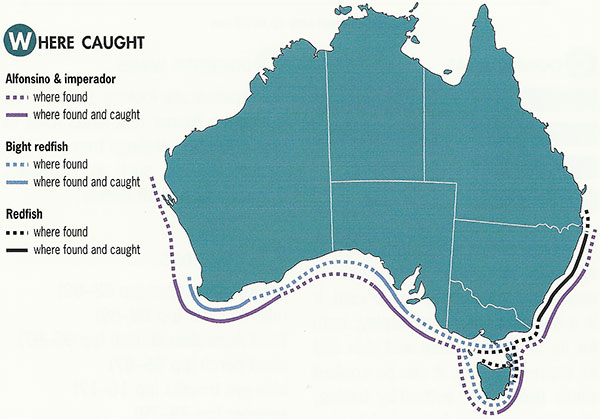Bight redfish is a silvery-red colour, with red and silvery white stripes along the sides, a reddish head and a red eye.
Redfishes are ideally suited to baking, shallow frying and grilling. An excellent method of preparation for these species is the Cajun style of marinating or coating the fillets in red chilli, ground cumin and coriander and cooking them over a very high heat.
Catch limits
| Catch limit | Fishing Mortality* | Biomass** |
|---|---|---|
Catch limit 935 tonnes For the 2025–26 Season | G;Not subject to overfishing | G;Not overfished |
* Fishing mortality status relates to the level of fishing pressure on a stock - specifically, whether fishing mortality in the year being assessed is likely to result in the stock becoming overfished or prevent the stock from rebuilding from an overfished state. If fishing mortality exceeds either of these thresholds, a stock is considered to be subject to overfishing.
** Biomass status relates to how many fish there are - specifically, whether the biomass in the year being assessed is above the level at which the risk to the stock is considered to be unacceptable. The HSP defines this level as the limit reference point, below which the stock is considered to be overfished.
Scientific name: Centroberyx gerrardi
Family: Berycidae
Other names: Redfish, nannygai, golden snapper, red snapper, red squirrel-fish
Description: Bight redfish have a moderately deep, compressed body and a large head. The body is usually silvery red with pale spots on the scales forming stripes. There is a single dorsal and anal fin. The tail fin is deeply forked. Bight redfish have large red eyes and an oblique mouth that extends back to the posterior margin of the eye.
Size (length and weight): Up to 66 cm in length and 4.6 kg. Bight redfish are larger than redfish (C. affinis).
Life span: Up to at least 70 years old.
Habitat: Bight redfish are endemic to the temperate waters of Australia in the Great Australian Bight. They often occur in large schools on rocky reefs and muddy substrates on the continental shelf and upper slope. Bight redfish can be found down to depths of about 500 metres. Bight redfish are thought to school according to sex. Juveniles are sometimes found in estuaries.
Prey: Bentho-pelagic fish and pelagic crustaceans.
Predators: Probably larger fish and sharks.
Reproduction: Bight redfish reach reproductive maturity at about 9 years of age. Spawning occurs during summer and early autumn. They form spawning aggregations above ‘lumps’ on the seabed. Females spawn multiple times during the spawning season but overall fecundity is thought to be low (0.6-1.5 million eggs per season).
| Fishery found in | Gear used | Catch of species is targeted or incidental |
|---|---|---|
| Southern and Eastern Scalefish and Shark Fishery – Great Australian Bight Trawl Sector | Bottom trawl | Targeted |
The Commonwealth catch of bight redfish around the south east of Australia is managed by quota. Which means the catch of this fish by commercial fishers is restricted by weight.
Commercial fishers are required to fill in records of their catch, during each fishing trip and when they land their catch in a port. This helps us keep records of how much is being caught.
AFMA decide on the amount that can be caught over multiple years from expert advice and recommendations from fisheries managers, industry members, scientist and researchers.
Bight redfish are found around rocky reefs and muddy sea floors. They are most commonly caught in shelf waters at a depth of approximately 120-200 metres.
Bight redfish are prevalent in southern Australian waters particularly from Lancelin, Western Australia to Bass Strait. They are predominantly caught in the Great Australian Bight Trawl Sector of the Southern and Eastern Scalefish and Shark Fishery.
Catches of bight redfish peak in February to April.

Fishers use trawl nets to fish for bight redfish.
Sometimes, bottom trawling can catch unwanted species of fish (not the type of fish the net was supposed to catch). This is known as bycatch and it is monitored by on-board fishery observers who assess the environmental impact of the trawling.
Although it is not physically possible to trawl on reef structures, significant long-term damage can occur if sensitive habitat areas like corals, sponges and seagrass beds are trawled. To ensure these sensitive habitat areas are protected from trawling, management arrangements such as area closures are extensively used.
To reduce the impacts of fishing on the environment, AFMA have a number of management arrangements and strategies in place including:
- minimum mesh sizes for otter trawls to reduce the catch of small and juvenile fish
- mitigation devices to reduce interactions with threatened endangered and protected species
- closing some areas to fishing to protect vulnerable species and habitats.
Gear
Want to know more?
This is just an overview of bight redfish, if you want to know more see the links below.
This fish is managed under the Southern and Eastern Scalefish and Shark Fishery and under the High Seas Fishery.